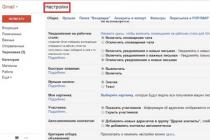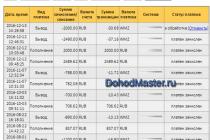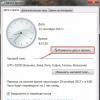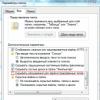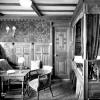Repair of high-voltage cables up to 10 kV, repair of cable lines.
Complex repair of 0.4 kV cable (basic) - from 52 thousand rubles.
Complex repair of 6/10 kV cable (basic) - from 61 thousand rubles.
Repair of one place of damage to a 380 volt cable - from 6 thousand rubles.
Repair of one place of cable damage 6000/10000 volts - from 11 thousand rubles.
The highest quality of work for a very reasonable price is the choice of a real businessman!
The visiting team of the company will detect the malfunction and professionally will fulfill cable repair, the need for which is due to any of the following reasons:
- Mechanical damage during work in the laying area;
- Defects on the couplings, both on the connecting and on the end;
- Previously committed violations of the assembly work technology;
- Movements and / or subsidence of soil;
- Local overheating of structural elements made of metal;
- Repair of cable lines the failure of which is due to a hidden factory defect;
- Aging of existing insulating shells due to long terms their operation or arising overloads.
We provide services for prompt repair of power cable operating under a load of up to 0.4 kV, and we also carry out the whole range of repair work on high-voltage cables up to 6 kV inclusive. Our teams carry out basic options repair of 10 kV cable.
Moreover, all of the above is done exclusively with our own materials, in the quality of which we are sure. That is why their price is already included in the cost of our work. The customer will not have to make any additional payments.
- Complex repair of the cable is carried out by our team in the city of Moscow.
- It is also possible to travel to other areas, but by prior agreement of the details of the work with the operator.
- Repair work on the cable is carried out depending on the cause of its damage and location.
- The mobile team of our company will arrive at the place of damage to the line in a short time after submitting the application and will carry out all the necessary work.
- We guarantee high quality works for a reasonable price.
Complex repair and cable restoration are carried out by the mobile team of the company on the territory Moscow and the Moscow region.
At the same time, work on the repair of a power cable can be carried out according to several methods, depending on the cause of the malfunction and the place of its detection. In each case power cable repair may include:
- search for a specific place of malfunction (cable line damage), which is performed step by step in several stages;
- earthworks providing access to the damage site;
- performance of actual repair work (restoration of armor cover, end fittings, couplings, shells, etc.);
- execution of tests of the restored section with registration of their results with the appropriate protocol.
Power cable repair(CL), which can be performed by us, in addition to the procedures listed in the price list, can be supplemented, at the request of the client, with the following technical activities:
- Detection of a specific short-circuit point, breakage or other damage to a single cable and / or cable line up to 10 kV inclusive.
- Installation of end and / or connecting couplings (heat shrinkable) for repairing a power cable 10 sq.
- Maintenance and repair of cable lines with the subsequent organization of control of their insulation for the presence of moisture.
- Performing test and electrical measuring work to determine the presence of leakage currents in cable insulation and the integrity of the latter. With the subsequent registration of the results with a protocol confirming them.
- High voltage cable repair on the territory of Moscow.
By ordering work from us, you save time, money and get a guaranteed high-quality solution to your problem. We respect our customers and our own business reputation!
During the operation of cable lines (KL), damage can occur in cables, couplings or terminations. The damage is in the form of electrical breakdown.
During the current repair of cable lines, the following works are performed: inspection and cleaning of cable channels, tunnels, routes of openly laid cables, end funnels, couplings, straightening of cables, restoration of lost markings, determination of the heating temperature of the cable and control of corrosion of cable sheaths;
grounding check and elimination of detected defects; checking access to cable wells and serviceability of well covers and constipation on them;
re-laying of individual sections of the cable network, testing increased voltage(for cables with voltage above 1 kV or checking insulation with a megohmmeter for cables below 1 kV), refilling funnels and couplings with cable mastic, repairing cable ducts.
During overhaul of KL perform:
partial or complete replacement (as required) of sections of the cable network, painting of cable structures, re-cutting of individual end funnels, cable couplings, replacement of identification marks, device of additional mechanical protection in places of possible cable damage.
Repair of cables laid in trenches. If it is necessary to replace the cable line or part of it, the opening of the improved coatings is carried out with the C-850 electric concrete breaker or the C-849 electric hammer, the C-329 motorized concrete breaker, and the S-358 pneumatic concrete breaker.
The coating material is dropped on one side of the trench at a distance of at least 500 mm from the edge, and the soil on the other side - at a distance of at least 500 mm from the edge. The trench is dug in a straight line, and at turns - extended to ensure the laying of cables with the required radius of curvature.
Trenches, in the absence of groundwater and underground structures, are dug without fixing vertical walls to the depth indicated below (in m):
In sandy soils ............................................... ................................................. one
In sandy loam ................................................ .................................................. ...................... 1.25
In loams, clays .............................................. .................................................. 1.5
In especially dense soils .............................................. .................................................. .. 2
Trenches in places of movement of people and vehicles are fenced and warning signs are installed near them, and at night - additional signal lighting. The distance between the fence and the axis of the nearest rail of a normal track should be at least 2.5 m, and a narrow track - at least 2 m.
Before laying new cables in the trench, perform the following work: fix the pipes in the trench at the intersections and convergence of the route with roads, underground utilities and structures; remove water, stones and other objects from the trench and level its bottom; make a backfill with a thickness of 100 mm at the bottom of the trench with shallow soil and prepare shallow soil along the route for dusting the cable after laying; bricks or reinforced concrete slabs are prepared along the route to protect the cable when such protection is necessary. Materials subject to rotting and decomposition in the ground (wood, sand-lime brick, etc.) must not be used to protect cables.
In places of intersections and approaches to engineering structures, concrete, reinforced concrete, ceramic, cast iron or plastic pipes are used. Steel pipes are used only to perform the passage of a section of the route using the pound puncture method.
The laying depth for cables with voltage up to 10 kV from the planning mark should be 0.7 m. Before laying the cable, an external examination of the upper cable turns on the drum is performed. If damage is found (dents, punctures on the coils, cracks in the "splash guard", etc.), the cable is allowed to be laid only after cutting out the damaged areas, checking the insulation for moisture and soldering new splints on the cable ends. During repair work, rolling out the cable from the drum is most often performed using a winch.
Allowable tensile forces for cables with voltage up to 10 kV are given in table. The pulling force during cable rolling with a voltage of up to 10 kV is controlled with a dynamometer by two experienced fitters who are at the drum and monitor the cable unwinding.
Permissible tensile forces during rolling for cables up to 10 kV
Section ka white, mm 2 | Allowable effort, kN, when pulling |
|||||
for the aluminum shell voltage, k | Lcable on | |||||
many wire aluminum | single-wire |
|||||
* Pulling cables with plastic and lead sheaths is allowed only by the conductors. ** Conductor made of soft aluminum with a relative removal of at least 30%.
Cables are laid with a margin equal to 1-3% of its length (snake), in order to exclude dangerous mechanical stresses during soil displacements and temperature deformations, the cable is laid with a snake when pulled by a winch after the end of rolling from the drum in the process of laying the cable to the bottom of the trench. When laying cables in parallel in a trench, their ends, intended for the subsequent installation of couplings, are positioned with a shift of the connection points by at least 2 m. , protecting the couplings from damage in case of possible soil displacement and temperature deformations of the cable, as well as in case of re-cutting of the couplings if they are damaged.
In cramped conditions with high flows of operating cables, expansion joints can be positioned in a vertical plane, placing couplings below the level of cable routing. The number of couplings per 1 km of replacement cable lines should be a day for three-core cables 1-10 kV with a cross-section of up to 3 x 95 mm 2 no more than 4 pcs., And a cross-section of 3 x 95 * 2 x 240 mm 2 - 5 pcs.
Replacement of cables in blocks.
Defective cable lines are usually replaced by using reserve openings in block sewers. The well is inspected by two electricians under the supervision of the work supervisor (foreman). In this case, one electrician in an electrician's belt with a rope tied to it is lowered into the well, and the second electrician, who has the end of the rope in case of helping the first, remains outside at the open hatch of the well.
To avoid an explosion when working in the wells, do not smoke, light matches and use open fire. When working in a well, you can use portable lighting fixtures for a voltage not exceeding 12 V. A fence in the form of tripods with warning signs and lanterns is installed above the open hatches of the wells.
The maximum permissible tensile forces of cables of brands VVG, AVEG, VRG and AVRG with fastening the rope for the conductors can be taken according to table. with a coefficient: for small veins - 0.7; for aluminum conductors made of solid aluminum - 0.5; for aluminum conductors made of soft aluminum - 0.25. To reduce the pulling forces when pulling the cable, it is allowed to use a lubricant that does not contain substances that adversely affect its sheath (grease, solid oil). Consumption of grease is 8-10 kg for each 100 m of cable.
The cable is pulled at a speed of 0.6-1 km / h and, if possible, without stopping, in order to avoid large pulling forces when starting the cable. After the end of the broach, the cable is laid in the well on the supporting structures, its ends are sealed, and elastic pads (for example, sheet asbestos) are placed in all places where the cable exits from the channels of the block to protect its sheath from abrasion.
Cable rolling in a tunnel using rollers:
1 - cable drum; 2 - corner guides; 3 - linear spacer rollers; 4 - angular rolling roller; 5 - cable; b - winch cable
After installation, the couplings in the well are placed in a split protective fireproof casing.
At the inputs of blocks in a building, tunnels, etc., the holes in the blocks after laying the cables are sealed with a non-combustible and easily destructible material. In places where cables come together at a distance less than the allowable one (for example, in places where cables exit from pipes, at intersections, etc.), asbestos-cement rings are put on the cables.
Replacement of cables in cable rooms.
In cable rooms, it is allowed to lay only cables without an external combustible cover, for example, cables having a fireproof fibrous cover over the armor or a fireproof hose made of polyvinyl chloride or other materials of equal fireproofing, as well as cables with a fireproof sheath.
If, when replacing, a cable with a combustible outer cover is used, then the cover is removed along the entire route section inside the cable structure to the very point of exit from the pipe or opening. Unarmoured cables with a polyethylene sheath cannot be laid indoors due to fire safety conditions.
Replacement of cables in production facilities.
Inside industrial premises, only armored cables without a combustible outer cover and unarmored cables with a fireproof sheath can be laid. In rooms with an aggressive environment, cables with PVC and other sheaths are used that are resistant to the effects of an aggressive environment.
The lifting and laying of new cables on trays and in boxes on short sections of the route is carried out from mobile towers, platforms, scaffolds, ladders, etc. Cables on trays are laid in one row. You can lay cables without a gap between them, as well as bundles close to each other in 2-3 layers (in a bundle) and, as an exception, in three layers. The outer diameter of the bundle should be no more than 100 mm.
In boxes, cables and wires are laid multilayer with arbitrary mutual arrangement... The height of layers in one box should not exceed 150 mm.
Features of the use of cables of the AAShv brand.
AAShv cables are used in accordance with the "Unified technical guidelines for the selection and use of electrical cables". These cables are not laid or rewound at ambient temperatures above + 30 ° C and below -20 ° C.
For any type of installation, the cable route must have a minimum number of turns, as a rule, no more than three per construction length, not counting the turns when the cable is inserted into the building and structures. The laying of cables in pipes is allowed only on straight sections with a length of no more than 40 m and at inputs to buildings and cable structures.
The inner diameter of pipes used for laying cables of the AASh brand, in all cases, must be at least two times the diameter of the cable. To protect cables from mechanical damage in vertical sections, sheaths made of sheet steel are used.
In operating cable structures under difficult conditions for mechanized laying, they use manual way... When laying cables manually, rubbing them against the ground, floor, walls, etc. should be excluded. Unloading, loading and transportation of AASHv cable at temperatures below -10 ° C is carried out with extreme caution.
When the cable is heated by a three-phase current, all cable cores are short-circuited at its inner end, and with single-phase or direct current, in addition, two cable cores at its outer end. One wire of the circuit should be two cores connected in parallel, and the second wire - the third core of the cable. The values of the current strength during heating of the cables are given in table.
Allowable current values when heating cables, A
Repair of the protective hose of the AAShv cable.
Repair of damage to the protective hose is carried out by welding in a stream of hot air at a temperature of 170-200 ° C using a welding gun with electric heating of air or a gas-air gun. In this case, compressed air is supplied with a pressure of 0.98 * 104 - 3.9 * 104 Pa from a compressor or a compressed air cylinder.
As an additive for welding, a polyvinyl chloride rod with a diameter of 4-6 mm is used. The places to be repaired are cleaned with a cable knife before welding, cut out foreign inclusions and cut off the protruding edges and seizures in the damaged areas of the hose. Hose breaks are repaired using PVC patches or split cuffs.
The patch is made of plastic so that its edges overlap the gap by 1.5-2 mm. Around the entire perimeter, the patch is welded to the hose, then the filler rod is welded along the formed seam, and the protruding surfaces of the rod are cut off and the seam is aligned at the weld point.
When repairing a hose using a split cuff, cut a piece of PVC tube 35-40 mm longer than the damaged area, cut the tube lengthwise and put it on the cable symmetrically to the damaged area. The cuff is temporarily fixed with polyvinyl chloride tape with a pitch of 20-25 mm, the end of the bar is welded at the junction of the cuff with the hose, and then the bar is laid and welded around the end of the cuff. The fastening tapes are removed, the bar is welded along the cuff cut, the protruding surfaces of the bar are cut off and the final alignment of all welds is performed.
When repairing punctures, small holes and cavities, the place of damage in the hose and the end of the filler rod are heated for 3-5 seconds with a stream of hot air, the end of the rod is pressed and welded to the hose at the place of heating. After cooling, after making sure of the strength of the welding of the bar, it is cut off.
In order to seal the hose and align the welding seam, the repair site is heated until signs of melting appear, a piece of cable paper folded in three to four layers is pressed against the 380 heated place. For reliability, the operation is repeated 3-4 times.
When the cable is laid open, the hose can be repaired by winding at least two layers, with an overlapping adhesive PVC tape and coated with PVC varnish No. 1.
Connection and termination of cable cores and wires.
Contact connections of conductive conductors can be performed by crimping, welding or soldering.
Technological operations for connecting and terminating cables during repair are similar to those during installation and are discussed in detail above.
When repairing the KL armor, the damaged part is removed, the edge of the armor is soldered with a lead sheath, and the unarmored part is protected with an anti-corrosion compound. If it is necessary to repair the cable sheath, then on both sides of the place of its damage, inspect the belt insulation, check the top layer of insulation for moisture. For this, strips of paper insulation are removed from the damaged cable and immersed in paraffin heated to 150 ° C. Cracking and foam emissions indicate moisture penetration into the cable under the lead sheath. If there is no moisture inside the cable, a cut lead pipe with two filling holes is put on the damaged part of the sheath. The pipe is made of rolled lead (two halves). It should be 70-80 mm larger than the exposed part of the cable. After filling with hot mastic, the pipe is sealed along the seam and a copper band is applied to it, which is soldered to the lead sheath. If there is moisture inside the cable, the damaged area is cut out.
Control questions
- What work is performed during the current repair of cable lines?
- What work is performed during the overhaul of cable lines?
- How are sections of cable lines connected?
- What technological methods are used for cable termination?
In accordance with the requirements of RD 34.20.508 “Instructions for the operation of power cable lines. Part 1. Cable lines with voltage up to 35 kV "current repairs can be emergency, urgent and planned.
Emergency repair - repair when, after disconnecting the cable line, the voltage on high or low voltage cables, including temporary hose cables, or when the reserve line to which the load is transferred is unacceptably overloaded, and there is no possibility of further unloading or consumer limitation is required.
Urgent repair - repair, in which receivers of the first or especially important second category are deprived of automatic backup power, and for receivers of all categories, the load on the remaining cable lines causes their overload or consumer restriction. TO urgent repair repair crews start cable lines at the direction of the management of the energy service during the work shift.
Electricity receivers of industrial enterprises are divided into the following groups:
1 group - receivers of three-phase current with voltage up to 1000 V, frequency 50 Hz;
Group 2 - receivers of three-phase current with voltage above 1000 V, frequency 50 Hz.
1st category of power supply- receivers, an interruption in the power supply of which may entail danger to human life or significant material damage associated with damage to equipment, mass rejection of products or long-term disruption of a complex technological production process.
Scheduled repair - repair of all cable lines not listed above, which is carried out according to the schedule approved by the management of the energy service.
Plan - a schedule of cable lines repairs is drawn up on a monthly basis on the basis of entries in the logs of rounds and inspections, the results of tests and measurements, as well as according to the data of dispatch services.
Overhaul of cable lines is carried out according to an annual plan developed annually in the summer for the next year based on operating data.
When drawing up a plan overhaul the need to introduce new, more modern types cables and cable fittings. It is planned to repair cable structures and all work related to the serviceability of lighting, ventilation, fire-fighting equipment. It also takes into account the need for partial replacement of cables in individual sections that limit the transmission capacity of the lines or do not meet the thermal resistance requirements in the changed network operating conditions with increased short-circuit currents.
Repairs of cable lines are simple, not requiring large labor costs and time, and complex, when the repair takes several days.
Simple repairs include, for example, repairing outer covers, painting and repairing armor tapes, repairing metal shells, repairing end fittings without dismantling the body. The listed repairs are performed in one shift by one team (link).
Complex repairs include such repairs when it is necessary to replace long cable lengths in cable structures with preliminary dismantling of a cable that has gone out of service.
Let us consider in detail the technological process of repairing a high-voltage cable that failed in an emergency in winter, since it is with such a repair that the working conditions of an electrician are the worst. A diagram of the technological process for repairing a cable that failed in an emergency in winter is shown in Figure 2.
Signal arrival
The signal is sent to the dispatcher on duty of the RES to the computer. Upon receipt of information on violations of work, the duty dispatcher of the RES must.
Various reasons can lead to the failure of cable lines, from natural wear of insulation and mechanical damage to the cable to errors in calculations and incorrect actions of the service personnel. In turn, damage to cable lines often leads to accidents, fires, fires and electric shocks. To prevent such consequences, you need to regularly measure the insulation resistance of cables. There are two ways to solve this problem:
- Provide staffing table specially trained people with the admission group necessary for the implementation maintenance and repair of cable communication lines and power cables.
- Instruct professionals to carry out such work by concluding a contract for Maintenance cable lines.
Repair of power cable lines
If the power cable is damaged, the supply of electricity through it stops. In this case, you need:
- Determine and eliminate the cause of the cable damage, so that the already repaired section does not fail when power is applied after repair work.
- Using special devices, find the place of damage to the cable.
- Repair the cable line. Depending on the scale of damage, it can be local or requiring replacement of the entire section of the cable line. Cable workers perform the necessary mechanical work with the cable route (open / close a trench, install couplings, cut / strip the cable, etc.). At the same time, they actively interact with employees of the electrical laboratory, who indicate the problem area, carry out current monitoring and final check before energizing.
Installation and repair of power cable lines 10/6 / 0.4 kV must be carried out by trained specialists with appropriate approvals. To eliminate the damage, cut the cable at the damaged area and install a cable gland. It is used to securely connect, terminate or branch off power cables, and to connect them to overhead power lines and electrical devices.
In the process of cutting the cable, all its layers from the outer sheath to the phase insulation of the current-carrying conductor are sequentially removed with some shift. This is done to further strengthen or restore the insulation, or to replace the damaged area with an insert. Installation of the coupling is a difficult and demanding job that allows you to restore the properties of the cable line, which were lost due to damage. Such operations are performed by electricians-muffers who have undergone special training and received permits for the implementation of such work.
Repair of communication cables
First of all, the broken connections are switched to workable pairs, and electrical measurements and a thorough examination are carried out to clarify the area of damage. The cable route is viewed, the viewing devices are opened, the rupture zones are checked, and the air pressure is determined. If the problem area is located within the viewing device, after removing the coupling, this gap is dried.
If damaged separate pairs lived, the plinth opens and is visible from the inside. The cores are soldered, burrs and solder beads are smoothed out, the core or pin is insulated, the pin is adjusted and other repair operations are performed. The skirting board can be dried with hot air or washed with cable compound. Failed terminals require replacement. At the end of the repair, the operation of the connections is checked.
Repair of a fiber-optic communication line (FOCL)
Kirov Department of Education
state educational institution
primary vocational education
vocational school No. 23
THESIS
TOPIC: maintenance and repair of cable lines
Completed: student of group No. 35
Bobkov Yuri Alexandrovich
Checked by: teacher Sobolev V.A.
Introduction.
Power cables.
1 Arrangement of power cables.
2 Cable blocks, overpasses, galleries, collectors, trenches.
3 Selection and use of cables.
Determination of places of damage in cable networks
1 Types and nature of damage to cable lines
2 Structure of the fault location search system
3 Characteristics of high-frequency OMP methods
4 Characteristics of low-frequency OMP methods
Repair of cable lines.
1 General repair instructions.
2 Repair of protective covers.
3 Repair of metal shells.
4 Restoration of paper insulation.
5 Repair of current-carrying conductors.
6 Repair of couplings.
7 Repair of outdoor terminations.
8 Repair of end fittings.
9 Repair of cable lines 0.38 ... 10 kV.
Maintenance of cable lines.
Bibliography.
Appendix.
Introduction
As you know, the basis for reliable power supply to consumers with electrical energy is the trouble-free operation of cable lines. Uninterrupted power supply to consumers of urban networks and industrial enterprises depends on new, progressive technological solutions adopted at the design stage and the use of modern cable fittings, on high-quality cable laying and strict compliance with all requirements for the operation of cable lines.
Despite the growing quality of insulation of cable lines, damage cannot be ruled out. Moreover, the specific amount of damage is a fairly stable characteristic of a certain class of electrical networks.
Determination of places of damage (OMP) is the most difficult and often the most time-consuming technological operation to restore a damaged network element. This is an operational task of dispatching services of electrical networks.
The cost of weapons of mass destruction make up a significant part of the operating costs in the power grid. The share of capital expenditures on devices for weapons of mass destruction in the total capital expenditures is relatively small. The introduction of progressive methods and means of weapons of mass destruction gives a significant economic effect. It consists of timely identification of weak points in cable lines, by conducting preventive high-voltage tests, reducing power supply interruptions, reducing the amount of repair work and reducing the cost of earthworks in the summer. The set of operations to search for faults and restore the operability of the cable line is considered as a single interconnected system.
1. Power cables
1 Power cable arrangement
Power cables are designed to carry electricity used to power electrical installations... They have one or more insulated conductors enclosed in a metal or non-metallic shell, over which, depending on the conditions of installation and operation, there can be a protective cover, and, if necessary, armor.
Power cables consist of conductive cores, insulation, sheaths and protective covers. In addition to these basic elements, shields, neutral conductors, protective ground conductors and fillers may be included in the design of power cables (Fig. 1.1).
Conductive conductors intended for the passage of electric current are basic and zero. The main conductors are used to perform the main function of the cable - the transmission of electricity. Zero cores, intended for the flow of the difference in currents of the phases (poles) with their uneven load, are connected to the neutral of the current source.
Protective grounding conductors are auxiliary and are designed to connect non-energized metal parts of the electrical installation to which the cable ... is connected to the protective grounding circuit of the power source.
Insulation serves to ensure the required electrical strength of the conductive cores of the cable in relation to each other and to the grounded sheath (earth).
Screens are used to protect external circuits from the influence of electromagnetic fields of currents flowing through the cable, and to ensure the symmetry of the electric field around the cable cores.
Fillers are designed to eliminate free gaps between the structural elements of the cable in order to seal, give the required shape and mechanical stability of the cable structure.
Rice. 1.1. Cross-sections of power cables: a - two-core cables with round and segment conductors; b - three-core cables with belt insulation and separate sheaths; c - four-core cables with zero conductor sector, round and triangular; 1 - conductive core; 2 - zero core; 3 - conductor insulation; 4 - shield on a conductive core; 5 - belt isolation; 6 - filler; 7 - shield on core insulation; 8 - shell; 9 - armored cover; 10 - outer protective cover
The sheaths protect the internal elements of the cable from moisture and other external influences.
Protective covers are designed to protect the cable sheath from external influences. Depending on the design of the cable, the protective covers include a pillow, an armored cover and an outer cover.
Letter codes are assigned to various cable designs.
Power cables with paper insulation, impregnated or depleted, are intended for use in fixed installations and in the ground at temperatures environment from plus 50 to minus 50 ° С and relative humidity up to 98% at temperatures up to plus 35 ° С. They are manufactured for rated voltages of 1, 6 and 10 kV alternating current with a frequency of 50 Hz, but can be used in direct current networks (Fig. 1.2).

Rice. 1.2. Power cables: a - with paper cables; and b - rubber insulation; 1 - outer cover; 2 - armor tape; 3 - cable yarn; 4 - cable paper; 5 - shell; 6 - belt isolation; 7 - filler; 8 - conductor insulation; 9 - conductive core
Power cables with paper insulation, impregnated with a non-dripping compound, are intended for laying on vertical and inclined sections of routes without limiting the difference in levels and operation at ambient temperatures from plus 50 to minus 50 ° С and relative humidity of 98% at temperatures up to plus 35 ° С and are manufactured for voltages of 6 and 10 kV alternating current with a frequency of 50 Hz, but can also be used in direct current networks.
Power cables with plastic insulation, in a plastic or aluminum sheath with or without protective covers, are intended for the transmission and distribution of electricity in stationary installations with a rated alternating voltage of 0.66; one; 3 and 6 kV with a frequency of 50 Hz.
Cables can be operated at ambient temperatures from minus 50 to plus 50 ° C, relative air humidity 98% at a temperature of plus 35 ° C, including when laid outdoors with protection from solar radiation.
1.2 Cable blocks, overpasses, galleries, collectors, trenches
The main method of sewerage of electrical energy at industrial enterprises is cable lines. At large enterprises, the number of cable lines can reach 25,000 with a total length of up to 2,500 km. To accommodate such a number of cables, it is necessary to install special cable structures. The simplest and cheapest structure is an earthen trench, but since the number of damages in this method is about 40%, it is used less often compared to laying in special structures.
Enterprises rarely give preference to any one gasket method and more often use a mixed gasket. Used as structures:
Earthen trench. The depth of the trench from the planning mark for cables with voltage up to 10 kV should be 0.8 m, when crossing streets and squares - 1.1 m

Figure 1.1. Laying the cable in the trench
A shallower trench depth (up to 0.6 m) is allowed when entering cables into buildings, structures, as well as at intersections with underground structures, provided that cables are protected from mechanical damage in sections up to 5 m long. 10 kV is taken not less than indicated in table. 1.2 and Fig. 1.2. They lay the cables on the backfill, and cover them with a layer of fine earth on top,
free of construction waste and slag. The tracks are marked with identification marks fixed on the walls of permanent buildings and structures or on posts made of angle steel (pickets). Signs are placed at the corners and turns of the track, at the points of installation of couplings, at the intersections of communication lines (on both sides), at the entrances to buildings. Signs with dimensions of 100 x 100 mm indicate the voltage sign (red paint), the designation of the cable route, the distance from the structure (in numbers) and the direction to it (arrows), the number of the sign (in black paint). The background of the sign is white.

Figure 1.2. Trench dimensions for laying cables 1 ... 10 kV: B1 - size at the bottom of the trench; B2 - size at the surface of the earth; В3 - withdrawal zone
Approximate samples of identification marks:

Figure 1.3. Cable signs: a - trench; b - cable sleeve; c - turn the trench at an angle
Channel sizes:
Width - 600 ... 1200 mm, height - 300 ... 900 mm.
This method of laying well protects against mechanical damage, but where metal or corrosive substances can be spilled, the construction of cable ducts is not allowed (Fig. 1.5).
A cable tunnel is an underground structure (corridor) with supporting structures located in it for placing cables and couplings on them, which allows laying, repairs and inspections with free passage along the entire length (Fig. 1.6)
CT is constructed from precast reinforced concrete and is covered with waterproofing on the outside. Depth - 0.5m.
Passages in cable tunnels, as a rule, should be at least 1 m, however, it is allowed to reduce passages to 800 mm in sections with a length of not more than 500 mm.

Rice. 1.4. Prefabricated reinforced concrete channels: a - chute type LK; b - from prefabricated plates of the SK type; 1 - tray; 2 - floor slab; 3 - sand preparation; 4 - plate; 5 - base.

Figure 1.5. Options for laying cables in cable ducts: a - arrangement of cables on one wall on hangers; b - the same on the shelves; c - the same on both walls on suspensions; d - the same on one wall on hangers, on the other on the shelves; d - the same on both walls on the shelves; e - the same at the bottom of the channel
The tunnel floor must have a slope of at least 1% towards the water collectors or storm sewers. In the absence of a drainage device, every 25 m, drainage wells with a size of 0.4 x 0.4 x 0.3 m, covered with metal gratings, should be arranged. If it is necessary to move from one mark to another, ramps with a slope of no more than 15 ° should be arranged.
The tunnels should be protected from the ingress of ground and process waters and the drainage of soil and storm water should be provided.
Tunnels should be provided primarily with natural ventilation. The choice of the ventilation system and the calculation of ventilation devices are made on the basis of the heat release specified in the construction assignments. The temperature difference between the incoming and outgoing air in the tunnel must not exceed 10 ° C.
Ventilation devices should be automatically turned off, and air ducts should be equipped with remote or manual dampers to stop air from entering the tunnel in the event of a fire.
The tunnel must be provided with stationary means for remote and automatic fire extinguishing.
Tunnels should be equipped with detectors that react to the appearance of smoke and an increase in the ambient temperature above 50 ° C. Collectors and tunnels should be equipped with electric lighting and a power supply network for portable lamps and tools.
Long cable tunnels are divided along their length by fire-resistant partitions into compartments no more than 150 m long with doors in them no less than 0.8 m wide. Doors from the outer compartments must open into the room or out. The door to the room must be opened with a key from both sides. The outer door must be equipped with a self-closing lock that can be opened with a key from the outside. Doors in the middle compartments should open towards the stairs and be equipped with devices that fix their closed position. These doors open on both sides without a key.
The laying of cables in collectors and tunnels is calculated taking into account the possibility of additional laying of cables in the amount of at least 15%.
Power cables with a voltage of up to 1 kV should be laid under cables with a voltage higher than 1 kV and separated by a horizontal partition. It is recommended to lay various groups of cables, namely operating and reserve cables with voltage higher than 1 kV, on different shelves separated by horizontal fireproof partitions. As partitions, asbestos-cement slabs are recommended, pressed unpainted with a thickness of at least 8 mm. The laying of armored cables of all cross-sections and non-armored conductors with a cross-section of 25 mm2 and above should be carried out along structures (shelves), and non-armored cables with a conductor cross-section of 16 mm2 or less should be laid on trays laid on cable structures.
Cables in tunnels must be rigidly anchored at the end points, on both sides of the bends and at the joints.
In order to avoid the installation of additional couplings, the length of the cables should be chosen.
Each joint on the power cables must be laid on a separate shelf of the supporting structures and enclosed in a protective fire casing, which must be separated from the upper and lower cables along the entire width of the shelves by protective asbestos-cement partitions. In each tunnel and channel, it is necessary to provide free rows of shelves for laying couplings.
For the passage of cables through partitions, walls and ceilings, branch pipes made of non-combustible pipes must be installed.
In places where cables pass through pipes, the gaps in them must be carefully sealed with non-combustible material. The filling material should provide adhesion and be easy to break if additional cables are laid or if they are partially replaced.
Non-armored cables with a plastic sheath may be fastened with brackets (clamps) without gaskets.
The metal armor of cables laid in tunnels must have an anti-corrosion coating. The distance between the shelves of cable structures when laying power cables with a voltage of up to 10 kV must be at least 200 mm. The distance between the shelves when installing a fire-resistant partition when laying cables must be at least 200 mm, and when laying a connecting sleeve 250 or 300 mm - depending on the size of the sleeve (Fig. 1.7).

Figure 1.6. Arrangement of cables in the tunnel: a - rectangular tunnel; b - round tunnel; 1 - tunnel block; 2 - rack; 3 - shelf; 4 - lamp; 5 - zone of fire detectors and pipelines for mechanized dust removal and fire extinguishing; 6 - power cables; 7 - control cables
A cable collector is a structure intended for the general placement of cable lines, heat pipelines and water pipes.
The collector is constructed from reinforced concrete structures of round and rectangular sections. Collectors of circular cross-section are made at a depth of no more than 5 m in a closed way. The collector is equipped with ventilation, pumps and is controlled from the control room. It is necessary to provide telephone connection... Collector dimensions: diameter - 3.6 m; width - 2.5 m; height - 3.0 m (Fig. 1.9).
A cable block is a structure with pipes (ducts) for laying cables with associated wells.
Cable blocks are constructed from reinforced concrete panels 6 m long with 2-3 channels inside from asbestos-cement or ceramic pipes. The blocks are laid on a reinforced concrete cushion and protected with waterproofing. Depth of laying - not less than 0.7 m, and at intersections - not less than 1 m. The joints of the panels are filled with mortar, having previously laid a tow of tow into the gap. Through every 150 m, walk-through or branching wells are installed. The minimum height of the wells is 1.8 m. Block gaskets are the most reliable, but less economical.








